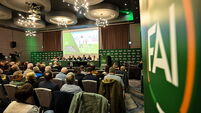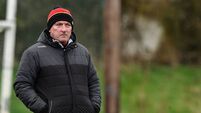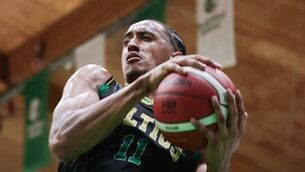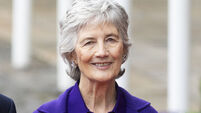Con

“Cahalane on Dr Con...
I didn’t want to wait out in CUH for half the night, that’s how I ended up with a vet X-raying my leg
IT was a trip to the greyhound track that changed his life. One Saturday evening almost 40 years ago Con Murphy, a young doctor, headed to the dogs with a pal, and they bumped into an official from the Cork County Board.
The official asked the medic if he was free to look after the Cork hurlers in their Munster SHC clash with Tipperary.
Next Sunday Dr Con, as he is known throughout the GAA, will stand on the sideline for his 25th All-Ireland final with Cork, but that was his start: listening to Christy Ring, then a selector, grumble about giving up his holidays to see Cork stumble over the line against Tipp 37 years ago.
Better days followed with the three-in-a-row.
“I was next to Ring for all the matches and that was fascinating,” says Dr Con, who was needed early and often in his new post. “We had to give Seanie O’Leary a fitness test the day before the 1976 All-Ireland final, and he clearly wasn’t fully fit. He was hampered in his movements.
“But Ring said, ‘We have to play him.’ I remember strapping Seanie up before the game, and at half-time he was lame. I said to Ring, ‘he’s had it,’ but he said, ‘No, no, we have to get him out there.’ Ring was a huge O’Leary fan.”
Ahead of the following year’s All-Ireland final O’Leary was in the wars again. Dr Con was needed when a sliotar hit the Youghal man in the warm-up: “It destroyed his nose. Before the parade I brought him into the dressing-room and Ring was inside with me, helping.
“When the bleeding stopped he turned to Seanie and said, ‘O’Leary, you won’t be using your nose at all for hurling, get out there.’
“Seanie had awesome strength. He was a great player. He scored 1-1 in the 1977 final and his nose was badly broken. He was out of action for a while after that game.”
Dr Con had a ringside seat for those three All-Irelands and when the bid for four was stopped by Galway in 1979, he was there for the end: “I was stitching John Horgan up after the game and we were crying, because you knew it was the end of an era — that the team wouldn’t assemble again in a dressing-room to play a match.
“And that was as hard as losing the four-in-a-row, to be there for the end of a team.”
He was well established by 1982, when Cork’s hurlers were hot favourites for the All-Ireland. Tony O’Sullivan got to know him then: “I came onto the Cork senior hurling team that year when I was just out of minor. The Doc was very good to me in terms of advice and getting me settled, because it was intimidating enough to come onto a settled team as a teenager.”
The day of the All-Ireland final the medic happened to see Kilkenny come into Croke Park: “They were so casual, so cool, but one of them told me later they were at home the night before and they saw some of the Cork lads at a concert on television, being interviewed, and it fairly fired them up.” Cork lost heavily that year. They were closer in 1983, when Dr Con saw Kilkenny’s goal early in the second half close-up: “We were walking out (after half-time) and I was still coming along behind the Cork goal with Johnny Clifford when Richie Power got the goal for Kilkenny straight from the throw-in.”
When Billy Morgan led the Cork footballers out of the wilderness later in the eighties, the Doc was on hand for the seismic clashes with Meath. Niall Cahalane got to know him along the way: “I respected him as a serious person, the team doctor, obviously. But as I got to know him I got to know the innocent roguery there, which I’d put down to the Bere Island background. He’s very witty.”
And very capable. Cahalane is close to the Doc to this day, which is not surprising given their shared hinterland.
“I often landed into him in crutches before championship games,” says Niall Cahalane. “I’d have said, ‘look, this whole thing is about the parade. Get me through that and I’ll look after myself afterwards. But if I go down in the parade, we’re in trouble.’”
That was the scenario in 1987, when Cahalane was a huge doubt ahead of the provincial decider.
“I was on crutches and went to his house for a fitness test on torn ankle ligaments the day before the Munster final. That was twelve o’clock on the Saturday but he got me right. I played the following day in the Munster final.
“Now, we drew that game, which was a catastrophe for me because I was on crutches until the replay, but sure we did the business the second day.”
When players were down he could keep their spirits up, says Cahalane. Take 1988.
“After losing that All-Ireland we should have been very down, miserable altogether, but we weren’t. We had a marvellous couple of days because of Con. He brought us back to Cork and he was like the Pied Piper, bringing us to establishments I never knew existed, that I was never in before or since.
“They were probably the funniest couple of days we had, and it was down to Con. He had the roadmap planned out, though it wasn’t a roadmap for peace.”
In the 1990 All-Ireland football final the medic saw definitive evidence establishing the toughest man who played for Cork in his time.
“Larry Tompkins,” Dr Con says. “The morning after winning the double I met him in the bar of the Burlington about noon.
“We had a drink and he said to me, ‘I made bits of my knee yesterday.’ I put my hand on his knee and it was out like a balloon. ‘You’ve done your cruciate anyway,’ I said.
“When I watched film of the game I saw him going into a tackle and he winced — I think it was with Robbie O’Malley — but he played on. He didn’t get any assistance. There were about 15 minutes to go at that stage, he played on, he kicked two frees and he collected the cup. He told me on the Monday and was operated on that Wednesday morning.”
IT was lighter when the hurlers collected the first half of the double that year. Tomás Mulcahy remembers the journey home.
“CIE would lay on a couple of carriages at the back of a scheduled train when you’re coming down to Cork on the Monday afternoon and on this occasion the Doc took the microphone in the team carriage and was MC — jokes, songs, calling lads up. Great crack.
“The following day, though, he got a phone call and was told that the microphone had been hooked up to the intercom for the entire train, that the 500 passengers had heard everything. He was mortified: I don’t think he came out of his house for a week after.”
And was it?
“I don’t know. You’d have to ask the man who phoned him. At a guess it could be a man who was a forward from Midleton.”
Niall Cahalane was in injury trouble again in September 1993. Where else did he go? “I was struggling badly for that All-Ireland final. I had a broken bone in my leg which just wasn’t healing properly, for some reason.
“A week before the game I went to see Con and he gave me a letter for an X-ray up in Cork University Hospital, but when I got there the queue was going out the door, so I headed back down to him. Whether or which we had to have it X-rayed, so he put me in the car and we headed off out around Togher.”
Cahalane wasn’t sure of their final destination until they pulled up outside Abbeyville. A veterinary hospital.
“That’s where I got my leg x-rayed. There were dogs howling and cats meowing and all I could see was Con going back and forth to see the scan with Tom McSweeney, God rest him, and the big trenchcoat billowing around Con.
“They ended up making a little cast for the injured area, something like a shinguard, and I played in that.
“But in fairness to him, that was down to me being impatient. I didn’t want to wait out in CUH for half the night, that’s how I ended up with a vet X-raying my leg.”
It didn’t end there for Cahalane. He had a conflab with the Doc again at half-time against Derry in that decider.
“I came in and I had severed ligaments on my collarbone. The Doc was cool as a cucumber, though. It was management’s call whether I went back out. I wanted to go back out, and I did, and afterwards I would have thought, was I right do so?
“I’d take full responsibility for that, though, because I was confident I could play, though I was probably so mule-headed that time.”
Eoin Cadogan was on the Cork football team in the Doc’s 24th All-Ireland final in 2010.
“I don’t know if I even think of him as a doctor so much as a friend, his house and his surgery are almost interchangeable. He’s always there for you and is always available. He relaxes guys and breaks the tension, but behind it all, when the crunch comes I often think he’s more nervous than any of us.”
When the Cork-Down All-Ireland football final was in the balance, the Doc intervened.
“In 2010 we came in at half-time and were perfectly calm — lads were just taking on water as usual, no panic — and Dr Con came in the door shouting, ‘We are not nervous! We are not nervous!’
“That epitomises him in that it meant that much to him for us to win. He’s been there for so long he’s been through a lot of heartbreak with lads, consoling them after losing All-Ireland finals or semi-finals.
“When we did win, in 2010, he enjoyed it all the way into the wee small hours, and he deserved it — the service he’s given Cork has been phenomenal, but the respect he’s held in all over the country is unbelievable as well.
“Players, managers, county boards, everyone respects him because they all know if he can do a turn for anyone, he will.”
“They come from all over the country for advice from Dr Con,” Tomás Mulcahy says. “That tells you everything. You see his relationship with the Kerry lads, with Clare, the North . . . he must have been to weddings in every county in Ireland in the last few years.
“He’s very decent to players long after they’ve packed in, which is appreciated by everyone.”
Tony O’Sullivan agrees: “We all ended up personal friends with him after finishing our playing careers, which is a good sign, and he’s always available at the end of a phone if you need help.
“He was also good with other teams. We’d be friendly with a lot of the Tipp lads we played against so often in the eighties, for instance, and the Doc would have been instrumental in building those friendships.”
Of course, there was a particular way you had to approach him before one of those fitness tests ...
“He made huge calls over the years,” says Cahalane. “It wasn’t all fun. He had to make hard calls about the medical welfare of players.
“So you had to get to him and get into his head and make sure he was comfortable in making his call: when you called to him to talk about your chances of playing, you couldn’t blink or look at the ceiling.
“You had to look him straight in the eye and convince him.
“We always reckoned he had a big say in terms of selection: that the selectors would put papers with the names of the subs in a hat and pull one out, but if Con didn’t agree he’d eat the paper.
“He didn’t get as far as retiring me. He was probably measuring me up but I self-destructed with a suspension and had to pack it in anyway.”
By the way, the pal who was with him at the dogs that night in 1976? The same man who’ll be alongside him on Sunday: Jimmy Barry-Murphy.
.












